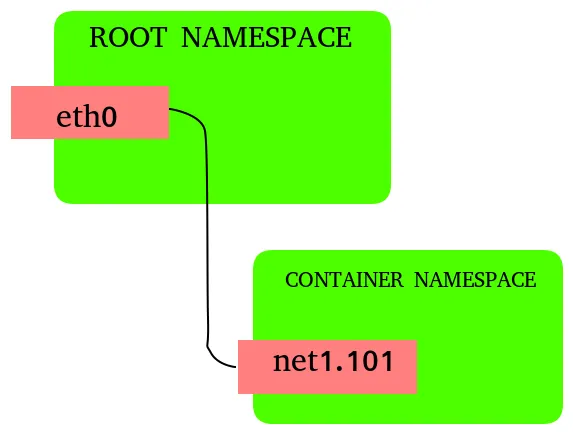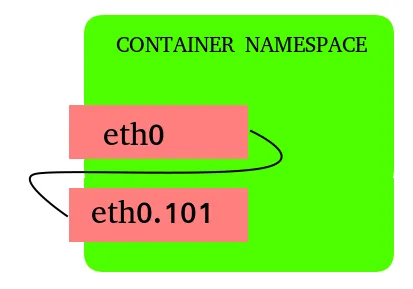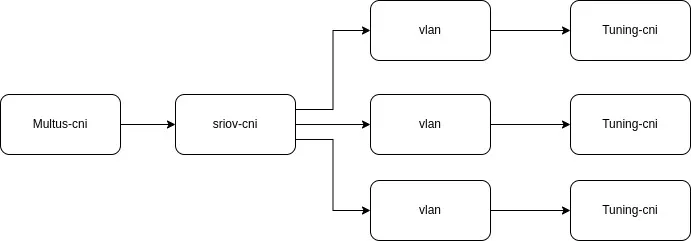Until recently, the existing vlan/macvlan/ipvlan CNI plugins only allowed users to create a VLAN subinterface based on a master interface in the host network namespace, and place the VLAN subinterface inside the container namespace.
Vlan based on node namespaced master
This approach had several drawbacks, the main being issues connected to configuration:
- A preconfigured master interface had to be present on the nodes.
- The vlan/macvlan/ipvlan configuration required knowledge about the node network configuration.
- Multiple network-attachment-definitions needed to be configured to use with different master/vlan combinations. Effectively a single network-attachment-definition could only be used on only one pod.
- The network-attachment-definitions had to be bound to nodes, since the available masters on different nodes could differ.
- The user had to keep track of which master/vlan combinations were already in use.
A recent feature coming in OpenShift 4.13 (Developer Preview) allows the vlan/macvlan/ipvlan interfaces to be configured using container namespace master interfaces.
Vlan based on container namespaced master.
This allows to create the master interfaces as part of the pod network configuration in a separate network-attachment-definition, and base the vlan/macvlan/ipvlan on this interface without requiring the knowledge of the network configuration of the node.
Installing
The feature will be available in OpenShift 4.13 as Developer Preview. No further installation is required.
Configuring a vlan/macvlan/ipvlan with container namespace master
To request the use of a container namespace master interface a new parameter “linkInContainer” has been added to the vlan/macvlan/ipvlan plugin configuration:
{
"name": "mynet",
"cniVersion": "0.4.0",
"type": "vlan",
"master": "eth0",
"mtu": 1500,
"vlanId": 73,
"linkInContainer": true
}
A sample use case for the use of the new feature is to create VLANs based on SR-IOV Virtual Functions. For this a SR-IOV network must be created, followed by the network-attachment definitions for the VLAN interface:
---
apiVersion: sriovnetwork.openshift.io/v1
kind: SriovNetwork
metadata:
name: sriov-network
namespace: openshift-sriov-network-operator
spec:
networkNamespace: mynamespace
resourceName: sriovnic
spoofChk: "off"
trust: "on"
---
apiVersion: sriovnetwork.openshift.io/v1
kind: SriovNetworkNodePolicy
metadata:
name: sriovnic
namespace: openshift-sriov-network-operator
spec:
deviceType: netdevice
isRdma: false
needVhostNet: true
nicSelector:
pfNames:
- ens3f0#0-4
numVfs: 10
priority: 99
resourceName: sriovnic
Followed by a VLAN network-attachment definition:
apiVersion: k8s.cni.cncf.io/v1
kind: NetworkAttachmentDefinition
metadata:
name: vlan-73
namespace: mynamespace
spec:
config: '{
"cniVersion": "0.4.0",
"name": "vlan-73",
"plugins": [
{
"type": "vlan",
"master": "ext0", ⓿
"mtu": 1500,
"vlanId": 73,
"linkInContainer": true, ❶
"ipam": {...}
}
]
}'
Note ⓿: the vlan configuration needs to specify the master name. This can be configured in the pod networks annotation, as shown below.
Note ❶: the linkInContainer parameter must be specified
The pod definition using the above specified networks must use the following networks annotation:
---
apiVersion: v1
kind: Pod
metadata:
annotations:
k8s.v1.cni.cncf.io/networks: '[
{
"name": "sriov-network",
"namespace": "mmirecki",
"interface": "ext0" ❷
},
{
"name": "vlan-73",
"namespace": "mmirecki",
"interface": "ext0.73"
}
]'
Note ❷: The name to be used as the master for the vlan interface.
Use case example
A example use case for this feature is the use of the vlan/macvlan/ipvlan based on SR-IOV virtual functions.
Multiple VLANs can be used with a single virtual function as the master interface. To allow additional configuration the tuning plugin can be used to further tune the created VLAN interfaces. The entire process can be performed in an automated manner, with no knowledge about the node interfaces other than that required to configure the SRIOV plugin.
Status
The TAP device feature will be available in OpenShift 4.13 as Developer Preview.
The use cases for the feature and available options are based on limited customer feedback. Additional feedback on possible use cases and missing functionality are welcome. Please contact your Red Hat account manager for further details.
저자 소개
채널별 검색
오토메이션
기술, 팀, 인프라를 위한 IT 자동화 최신 동향
인공지능
고객이 어디서나 AI 워크로드를 실행할 수 있도록 지원하는 플랫폼 업데이트
오픈 하이브리드 클라우드
하이브리드 클라우드로 더욱 유연한 미래를 구축하는 방법을 알아보세요
보안
환경과 기술 전반에 걸쳐 리스크를 감소하는 방법에 대한 최신 정보
엣지 컴퓨팅
엣지에서의 운영을 단순화하는 플랫폼 업데이트
인프라
세계적으로 인정받은 기업용 Linux 플랫폼에 대한 최신 정보
애플리케이션
복잡한 애플리케이션에 대한 솔루션 더 보기
오리지널 쇼
엔터프라이즈 기술 분야의 제작자와 리더가 전하는 흥미로운 스토리
제품
- Red Hat Enterprise Linux
- Red Hat OpenShift Enterprise
- Red Hat Ansible Automation Platform
- 클라우드 서비스
- 모든 제품 보기
툴
체험, 구매 & 영업
커뮤니케이션
Red Hat 소개
Red Hat은 Linux, 클라우드, 컨테이너, 쿠버네티스 등을 포함한 글로벌 엔터프라이즈 오픈소스 솔루션 공급업체입니다. Red Hat은 코어 데이터센터에서 네트워크 엣지에 이르기까지 다양한 플랫폼과 환경에서 기업의 업무 편의성을 높여 주는 강화된 기능의 솔루션을 제공합니다.




